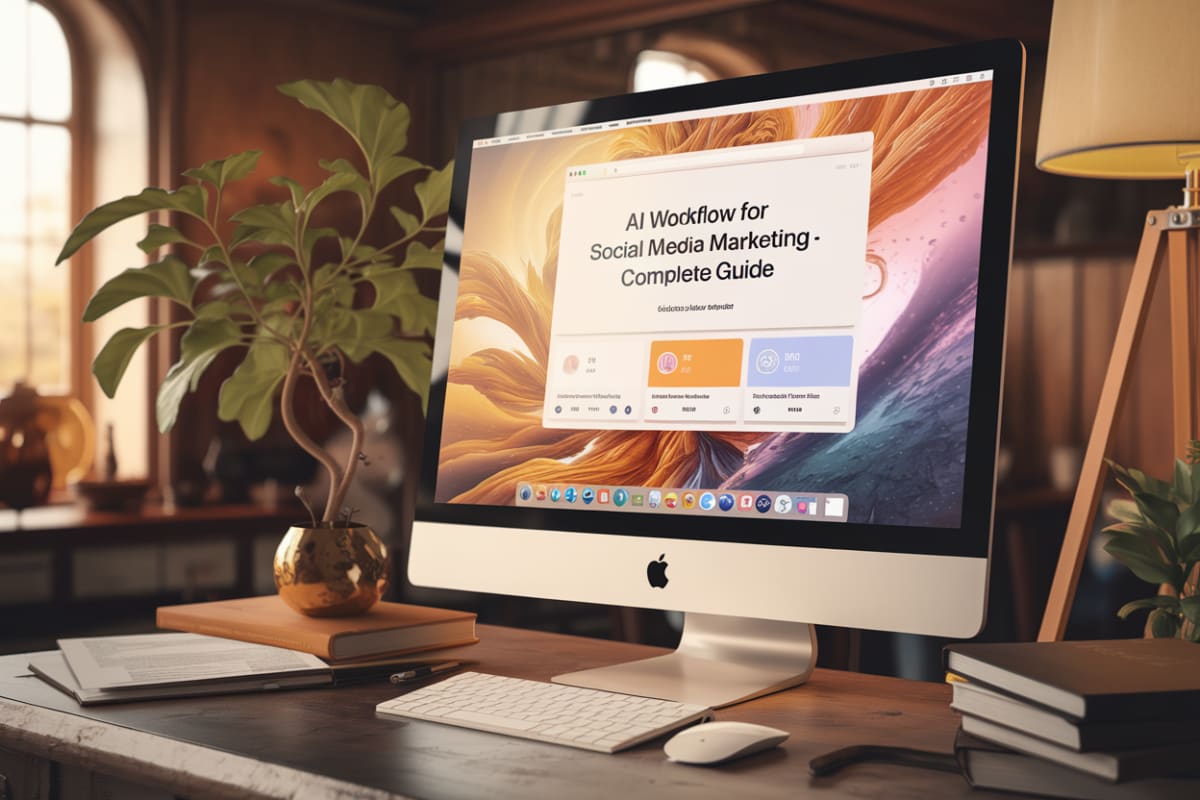Social Media A/B Testing: Complete Guide
What is A/B Testing in Social Media?
Definition of A/B Testing
A/B testing, also known as split testing, compares two versions of a marketing element to determine which performs better. This method involves creating two variations of content (e.g., ads, posts) and showing each to different audience segments. Marketers analyze engagement metrics such as clicks and conversions.
How A/B Testing Works
In social media, A/B testing involves:
- Identifying the Variable to Test: Select a single element to modify, such as a headline, image, or call-to-action (CTA).
- Creating Two Versions: Develop two distinct variations of the content, with only one differing element.
- Segmenting Your Audience: Randomly divide your audience into two groups to ensure unbiased results.
- Running the Test Simultaneously: Post both versions at the same time to control for external factors.
- Measuring Results: Analyze performance based on predefined metrics to identify the more effective version.
- Implementing the Winning Version: Use the better-performing content in future campaigns.
Key Metrics for A/B Testing
Common metrics to evaluate A/B testing outcomes include:
- Engagement Rate: Measures interactions (likes, shares, comments).
- Click-Through Rate (CTR): Percentage of users who click on a link or CTA.
- Conversion Rate: Percentage of users completing a desired action (e.g., sign-ups, purchases).
- Impressions: Number of times content is displayed.
- Reach: Number of unique users who see the content.
Examples and Case Studies
- Example of A/B Testing: A company tests two different headlines for a Facebook ad—one with a question and one with a statement. Analyzing which ad garners more clicks helps the company refine its messaging.
- Case Study: A/B testing at Sprinklr revealed that changing the color of a CTA button on social ads led to a 15% increase in clicks.
Best Practices for A/B Testing
- Test One Variable at a Time: Accurately gauge the impact of changes.
- Use a Sufficient Sample Size: Ensure enough participants to achieve statistical significance.
- Run Tests Over a Meaningful Duration: Allow sufficient time to gather data without external influences skewing results.
- Monitor External Factors: Be aware of events or changes that may impact results, such as holidays or social media algorithm changes.
How Do You Conduct A/B Testing on Social Media?
What is A/B Testing on Social Media?
A/B testing compares two versions of a piece of content to determine which performs better. This typically involves creating two variations of a post, ad, or other content and distributing them to separate audience segments.
Steps to Conduct A/B Testing
- Identify the Variable to Test: Choose a single element, such as the headline, image, call-to-action (CTA), or posting time.
- Create Two Versions: Develop two versions of the content with one differing element (Version A and Version B).
- Segment Your Audience: Randomly split your target audience into two groups to ensure unbiased results. Each sees one version of the content.
- Run the Test Simultaneously: Post both versions at the same time to control for external factors like time of day or day of the week.
- Measure the Results: Analyze performance based on predefined metrics to determine the more effective version.
- Implement the Winning Version: Use the better-performing content for future campaigns.
Key Elements You Can A/B Test
- Post Text: Experiment with post length, style, use of emojis, punctuation, and tone of voice.
- Call to Action: Optimize CTAs to encourage user engagement.
- Use of Image or Video: Test whether posts with images or videos perform better than text-only posts.
- Timing: Do morning posts perform better than evening posts?
- Hashtags: Explore the impact of hashtags on content reach and engagement.
Case Study Example
A company might run an A/B test comparing two different headlines for a promotional post. The version with a compelling, action-oriented phrase might yield a higher click-through rate and engagement than a more generic headline.
Best Practices
- Test One Variable at a Time: Focus on a single element to isolate its impact.
- Use a Sufficient Sample Size: Ensure your audience segment is large enough for statistically significant results.
- Run Tests for an Appropriate Duration: Allow enough time to gather meaningful data, but avoid running too long to prevent external factors from skewing results.
Implementing A/B testing enables marketers to make data-driven decisions that enhance engagement and optimize social media strategies effectively. Sources: Sprinklr, LinkedIn, Locowise.
What Are the Benefits of A/B Testing for Social Media Marketing?
Data-Driven Decisions
A/B testing allows marketers to make informed decisions based on actual performance data rather than assumptions. Comparing metrics such as click-through rates, engagement, and conversion rates between two versions of a post or ad helps identify what resonates with their audience. For example, Amazon tested different product images and descriptions to optimize conversion rates, demonstrating how data-driven decision-making leads to better outcomes Source Name.
Improved Engagement
A/B testing significantly increases audience engagement. Understanding which content formats, headlines, or visuals captivate users allows marketers to tailor strategies to boost likes, shares, and comments. For instance, testing different post lengths or using images versus text-only posts reveals what garners the most interaction Source Name.
Higher Conversion Rates
Continuous optimization of content through A/B testing leads to higher conversion rates. Testing elements like call-to-action buttons or landing pages helps discover the most effective combinations that drive users to desired actions, such as signing up for a newsletter or making a purchase. A significant example is Netflix, which A/B tests various elements of its user interface to enhance retention and maximize user engagement Source Name.
Enhanced ROI
Effective A/B testing maximizes return on investment (ROI) by ensuring marketing resources allocate to the highest-performing content. Identifying variations that yield the best results allows marketers to focus budgets on strategies that provide the greatest return Source Name.
Audience Insights
A/B testing reveals valuable insights into audience preferences and behaviors. Experimenting with different messaging, visuals, and targeting options helps marketers gain a deeper understanding of audience segments, informing broader marketing strategies. For example, media outlets frequently test different headlines and content formats to determine what drives subscriptions Source Name.
Continuous Improvement
A/B testing fosters a culture of continuous improvement. Regularly testing and iterating marketing strategies allows businesses to adapt to changing audience preferences and market conditions. Ongoing experimentation leads to incremental enhancements, resulting in sustained performance growth over time Source Name.
Practical Application
To implement A/B testing effectively, marketers should define clear objectives, select the right tools (such as Google Analytics or Optimizely), and ensure a statistically significant sample size. For instance, a brand might test two different ad copies on social media platforms simultaneously to see which generates more clicks or conversions Source Name.
What Metrics Should You Track in Social Media A/B Testing?
Key Metrics for Social Media A/B Testing
To effectively measure the success of A/B testing in social media campaigns, track various metrics that align with specific campaign goals. Here are the key metrics to consider:
1. Engagement Metrics
- Likes and Reactions: Indicates how well your content resonates with the audience. A higher number of likes suggests positive reception.
- Comments: Analyzing comments provides insights into audience sentiment and engagement quality. For instance, a campaign by a local fitness brand increased shares by 150% by focusing on user-generated content, indicating strong engagement.
- Shares: The number of times users share your content highlights its virality and relevance.
- Engagement Rate: This is calculated by dividing total engagements by the number of impressions. It helps gauge content effectiveness in engaging users.
2. Click-Through Rate (CTR)
- CTR: This metric shows how many users clicked on a link within your post or ad, indicating how effectively your content drives traffic. For example, optimizing CTAs in Facebook ads led to a 45% increase in CTR for one campaign, directly correlating with higher conversions.
3. Conversion Metrics
- Conversion Rate: Measures the percentage of users who take a desired action (like making a purchase or signing up) after interacting with your content. It is crucial for understanding the effectiveness of campaigns in driving results.
- Cost Per Conversion: This metric evaluates the cost-effectiveness of A/B tests, showing how much you spent on ads versus the number of conversions achieved.
4. Reach and Impressions
- Reach: Indicates how many unique users saw your content. A high reach with low engagement suggests the need for content refinement.
- Impressions: Shows the total number of times your content was displayed, including repeat views. It helps assess overall visibility.
5. Audience Growth Metrics
- Follower Growth: Tracking how your follower count changes during A/B testing indicates which content resonates well with users and leads to increased brand loyalty.
Example of A/B Testing in Action
In a case study involving eco-friendly sneakers, the brand tested user-generated content (UGC) versus studio photography to see which visual style drove more engagement. Analyzing engagement metrics, CTR, and conversion rates helped the brand determine which approach resonated better with their audience, leading to more informed marketing strategies.
Tools for Tracking Metrics
Platforms like Facebook Ads Manager and third-party tools such as Hootsuite or Google Analytics provide detailed insights into these metrics, helping marketers make data-driven decisions based on A/B test results.
Consider using Enrich Labs' AI Social Media Coordinator for seamless monitoring and analysis of social interactions. This tool autonomously manages and analyzes thousands of comments and DMs, allowing you to focus on higher-impact work while gaining unique insights from your A/B testing efforts.
How Long Should You Run an A/B Test on Social Media?
Duration Recommendations
The optimal duration for running an A/B test on social media varies based on several factors, including audience size, engagement patterns, and specifics of what is being tested.
General Guidelines
Minimum Duration: Most experts recommend running A/B tests for at least one to two weeks. This timeframe generally allows for collecting sufficient data to achieve statistical significance, especially for metrics such as engagement rates, click-through rates, and conversions.
- Example: A study by Fast Simon suggests a minimum of two weeks to gather enough data while avoiding anomalies that can occur over shorter periods, like weekends or specific events Fast Simon.
Maximum Duration: It is advisable not to extend A/B tests beyond six to eight weeks. Prolonged testing can lead to shifts in user behavior or external factors affecting results, making it harder to draw clear conclusions.
- Example: The Brandwatch article emphasizes that while tests should be long enough to gather reliable data, overly long tests can complicate results due to changes in audience behavior over time Brandwatch.
Factors Influencing Duration
- Audience Size: Larger audiences yield quicker results, while smaller audiences may require longer testing periods to achieve reliable metrics.
- Type of Content: Different types of content (e.g., posts versus ads) might have varying optimal testing durations. For instance, email A/B tests might only need a few hours or days, while social media content often requires more time to observe interactions Mailchimp.
- Seasonal Variations: Testing during peak times (e.g., holiday seasons) might yield quicker results due to increased user engagement; however, it may also introduce variability due to holiday shopping behavior. Conversely, off-peak times may necessitate longer testing periods to gather sufficient insights.
- Example: Locowise advises aligning tests with typical engagement patterns to ensure representative results Locowise.
Best Practices
- Consistency: Ensure both variations test under similar conditions, such as time of day and audience segmentation, to avoid bias.
- Monitoring: Regularly monitor test results for statistical significance but avoid making premature conclusions before reaching the predetermined duration.
Aligning the duration of A/B tests with these recommendations and factors enables marketers to optimize social media strategies effectively.
What Are Some Examples of Successful A/B Tests on Social Media?
A/B Testing on Meta (Facebook and Instagram)
Example: User-Generated Content vs. Studio Shoot
A brand tested two visual styles for an ad campaign promoting eco-friendly sneakers. They compared:
- Version A (UGC): A real customer photo in a casual setting.
- Version B (Studio Shoot): A high-quality image of the sneakers on a simple background.
Additionally, they tested two types of ad copy for each visual:
- Copy 1 (Community-Focused): "Join a movement of eco-conscious individuals..."
- Copy 2 (Product-Focused): "Crafted from 100% recycled materials..."
This setup resulted in four variations to analyze which combination drove the most engagement and conversions, demonstrating the effectiveness of A/B testing in optimizing ad performance on social media platforms like Meta. This approach allows brands to refine creative strategies based on direct audience feedback.
What Tools Can Help with A/B Testing on Social Media?
Overview of A/B Testing on Social Media
A/B testing on social media involves creating two versions of a post, ad, or campaign element. Marketers publish both versions to see which achieves the desired engagement level by targeting different audience segments. Benefits include understanding audience preferences, boosting conversions, and refining content strategies.
Key Tools for A/B Testing
Hootsuite: Offers A/B testing functionalities that allow users to test content performance across multiple platforms, including social media. Users can share alternate video links or titles and measure click-through rates and referral traffic to optimize strategies. Its freemium model supports basic experimentation, making it accessible for various users.
Optimizely: Primarily a web and feature experimentation platform, Optimizely adapts for social media campaigns. It supports A/B testing and personalization, allowing marketers to allocate traffic to different ad versions based on user behavior, optimizing engagement.
Enrich Labs' AI Social Media Coordinator: This top-tier solution autonomously moderates and analyzes thousands of comments and DMs across all major platforms. Custom-trained on your unique brand voice and guidelines, it streamlines the A/B testing process while providing actionable insights—helping you focus on higher-impact work that drives growth.
VidIQ: Mainly used for YouTube, this tool provides functionalities beneficial for social media A/B testing. It allows users to test different titles and thumbnails for their videos, enabling optimization based on engagement metrics.
YT Cockpit: This free tool is designed for YouTube but applies to social media strategies. It helps test video metadata, such as titles and descriptions, to maximize visibility and click-through rates.
Canva: Primarily a design tool, Canva assists in creating visually appealing social media posts. Users can test different graphic designs and measure effectiveness using social platform analytics.
Examples of A/B Testing in Action
- Hootsuite A/B Testing: A marketer could use Hootsuite to test two versions of a promotional post across Facebook and Instagram. One version might feature a vibrant image, while the other uses a more subdued color palette. Tracking engagement rates helps identify which visual approach resonates better with the audience.
- Optimizely: A brand could run an A/B test on a social media ad campaign by comparing different headlines and call-to-action phrases to see which combination leads to higher click-through rates.
Conclusion
Employing these tools allows marketers to make data-driven decisions, enhance audience engagement, and allocate resources effectively in social media strategies. Consider trying Enrich Labs' AI Social Media Coordinator to streamline your A/B testing process and maximize your team's productivity. Learn more about how our solution can transform your social media management at Enrich Labs.




